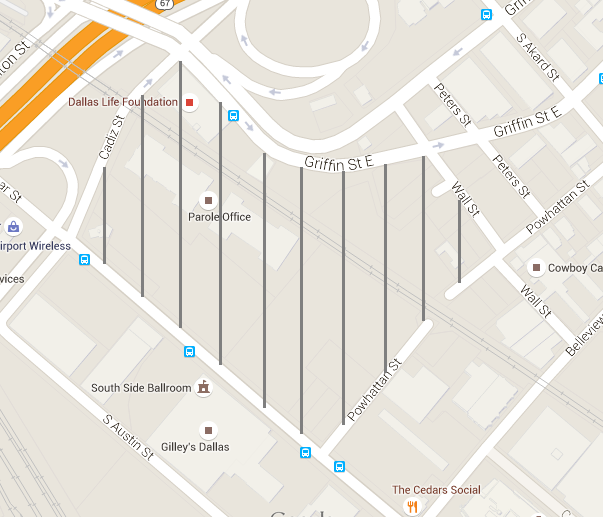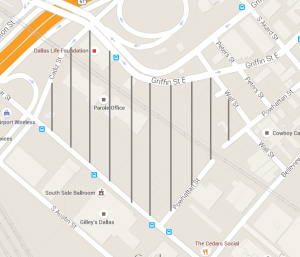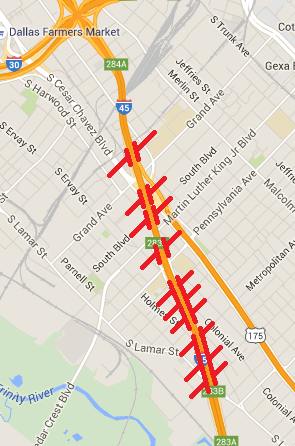Many of the neighborhoods surrounding downtown Dallas have seen a resurgence in development in the past decade. Uptown, Old East Dallas and Deep Ellum have all had their share of redevelopment. The Cedars, however, has lagged behind the rest. It’s strange because the neighborhood has a lot going for it — it’s close to downtown, land prices are cheap and there are quite a few great buildings just waiting to be repurposed. However, outside of Akard St. or Jack Matthews’ projects on S. Lamar St., the area hasn’t seen any significant reinvestment in a long time. Why is this?
It’s hard to know exactly. Some of it may have to do with the intense redlining by lenders in the years following World War II (Looking Back at Dallas: How Redlining Shaped the City) or maybe because, like West Dallas, this area was an industrial hub for a long time where manufacturing and fabrication dominated. As we know, manufacturing has long been in decline.
Although it’s difficult to know the exact reasons, one thing is clear in the Cedars. Basic infrastructure is desperately lacking, and it may be holding the neighborhood back. The streets are in disrepair, sidewalks are non-existent and, most importantly, the grid is fractured and incomplete. There are so many missing connections and dead-ends it’s hard to know where to begin.
There are large swaths of missing streets between S. Lamar St. and Griffin St.
And there are blocks of omitted roads between Parker St. and Grand Ave.
Not to mention all the nonsensical dead-ends found throughout the neighborhood (each red dot below represents a dead-end).
To be fair, some of this can be attributed to history. As mentioned, this area was an industrial hub and many of the missing connections shown above are due to the railroads crisscrossing the neighborhood and serving the companies that once made their home in the Cedars. The grid was carved up for the benefit of industry, but most of it is long gone. However, we can’t blame everything on industry. There is another relic in the neighborhood disrupting the grid – Interstate 45.
Up until the 1970s the Cedars was home to a thriving African-American community. In a great article, Tim Rogers details the community’s reaction to state officials’ plan to build a highway right through the middle of their neighborhood. The residents protested and even went to Austin to rally against the highway that they believed would destroy their neighborhood. Unfortunately, they were unsuccessful, and their premonition came true. Let’s take a look at I-45’s effect on the grid.
As you can see, about ten streets are literally cut in half by the highway. The highway completely disrupts local surface streets making it much more difficult for the grid to function as originally designed. In a city, local connectivity is king, and the grid is the mechanism for providing those connections. Favoring regional travel via highways over local travel via surface streets, produces regionally populated areas with dead zones in between, i.e., sprawl. Being in a dead zone is devastating for local businesses, which in turn affects residential quality of life.
How does this work in practice? Placing a highway in the middle of a neighborhood incentivizes local and non-local residents to disregard the surface streets and use the highway whenever most convenient. Most people will use the highway even if it means avoiding one stoplight because people naturally want to get to their destinations faster. This is human nature. However, the problem here is that commercial property values are, in part, determined by exposure and daily traffic counts. The busier a corner is the more valuable that land is to a commercial property owner. When you divert traffic away from the surface streets you are diverting potential customers. Moreover, non-locals that once drove past your local businesses simply bypass them now and don’t even know they exist. This becomes a self-perpetuating cycle that eventually produces these economic dead zones. Although unintended, the consequences are frighteningly real. Drive through the Cedars in and around I-45, particularly Martin Luther King Blvd., and note the countless failed businesses, empty buildings and vacant land.
Concerned citizens and city leaders are starting to notice the effects these highways have had on the urban core these past 50 or so years. There has been a call to examine the utility of these highways more closely and see if they still fit in our vision of Dallas. Let’s add I-45 to that list. We may discover that the city can survive and even thrive without the road or that there is a better route with less intrusive effects. For instance, a re-reroute along the banks of the lower Trinity might work better since the highway would still be integrated into the regional transportation network without dividing and destroying a neighborhood. Here’s what that may look like:
The above may not be feasible for many reasons. But the truth is we don’t really know until we take a closer look. In the meantime, there’s a lot of work to be done patching the grid in the Cedars. It’s only right that South Dallas shares in some of the recent economic success other parts of Dallas has experienced lately. We should prepare the Cedars for success in the post-industrial economy by investing in basic infrastructure so that the private sector can create a neighborhood that attracts new residents and businesses. It all begins and ends with the grid.










